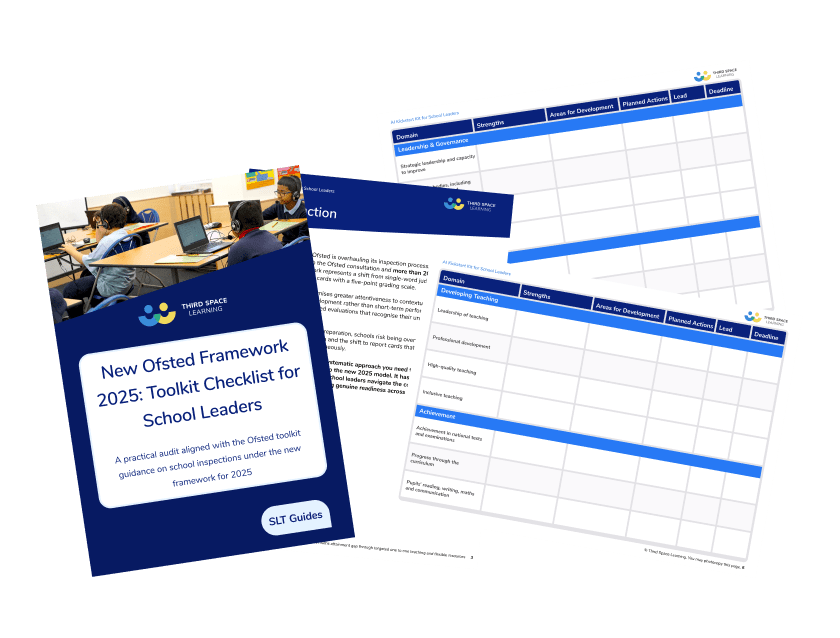Ofsted Inspection Framework 2025: What’s Changed, What Matters, and How to Prepare
Inspections are returning under a new Ofsted inspection framework, and every school needs to know what’s changed. The 2025 framework introduces report cards, new evaluation areas and a more collaborative inspection process, replacing the 2019 model.
Drawing on Zoe Hardman’s experience as an inspector in England and overseas, this guide explains what the changes mean, how the inspection process works, and what school leaders should focus on now.
You’ll find practical steps to help your staff feel confident, your evidence ready, and your safeguarding culture strong before Ofsted calls.
Key takeaways: what’s different in the 2025 Ofsted framework?
- What changed: The 2025 education inspection framework replaces the single headline grade with report cards across 11 evaluation areas; safeguarding is reported as met or not met.
- Approach: No routine deep dive methodology; inspectors and leaders agree on focus areas up front, usually aligned to your SIP, and start judging at the expected standard before considering strong or exceptional.
- Inclusion: The new inspection framework will focus on inclusion for children with additional needs in mainstream schools.
- Process: Expect a more collaborative inspection process: a substantive pre‑inspection call with the lead inspector, targeted evidence‑gathering, less paperwork, and greater emphasis on context and inclusion.
- Types of visit: Routine graded inspections for all state‑funded schools; monitoring inspections where any area is below the expected standard; ungraded inspections are removed
- Who’s in scope: Applies to maintained schools, academies, non‑association independent schools, early years settings, sixth forms, further education and skills providers, and young offender institutions.
- Do now: Refresh your self‑evaluation against the 11 areas, evidence impact not intention, brief all staff members on the school narrative, and check safeguarding culture and records are watertight.
What is the new Ofsted inspection framework?
The Ofsted inspection framework is a set of standards and guidelines for Ofsted inspections of maintained schools and academies, non-association independent schools, early years settings, further education and skills providers, prisons and young offender institutions and early years settings.
Along with the Ofsted inspection toolkit, the new Ofsted inspection framework 2025 aims to guide senior leadership and outline what to expect before, during and after an inspection.
The new education inspection framework (EIF), effective from November 2025, changes how Ofsted evaluates schools. Instead of one overall grade, each education provider receives a report card rating 11 evaluation areas on a five‑point scale from Exceptional to Urgent improvement. Safeguarding is graded separately as met or not met.
New Ofsted Framework 2025: Toolkit Checklist
A practical audit aligned with the Ofsted toolkit guidance on school inspections under the new framework for 2025. Includes an actionable checklist.
Download Free Now!Ofsted inspection framework updates
Ofsted carried out a ‘Big Listen’ consultation period and gathered feedback from education providers, parents and carers, and other stakeholders over 12 weeks, conclusing in April 2025. They then used this feedback to inform the new Ofsted framework, which has replaced the 2019 Ofsted inspection framework.
Initial feedback from educational providers suggests significant skepticism about the effectiveness of Ofsted’s proposed changes. There is a general consensus that the current changes to Ofsted will not sufficiently reduce staff pressure and workload. Ongoing dialogue between Ofsted and education providers remains crucial for shaping an effective evaluation process.
The new Ofsted framework for 2025 represents a major shift from the 2019 education inspection framework. The table below summarises the key updates every school leader should understand.
Ofsted inspection framework 2019 vs 2025
| Area | 2019 Framework | 2025 Framework | What This Means for School Leaders |
|---|---|---|---|
| Overall focus | Curriculum “quality of education” at the centre | Broader picture of school effectiveness across 11 evaluation areas | Prepare evidence/narrative across more domains, not just curriculum |
| Judgement structure | 4 graded judgements (Quality of Education, Behaviour & Attitudes, Personal Development, Leadership & Management) | Judgements replaced with a 5-point evaluation scale applied to each of the 11 areas | Understand new descriptors and map evidence to each area |
| Safeguarding | “Effective/Not Effective” but interpreted through L&M | Safeguarding becomes a gating judgement — if not met, overall evaluation cannot be “good” | Audit safeguarding culture, training and records rigorously |
| Curriculum | Focus on intent, implementation, impact | Curriculum evaluation distributed across teaching quality, inclusion, subject leadership, and progress | Clearer evidence of sequencing, inclusion & monitoring |
| Data expectations | Low-stakes; no expectation to generate additional internal data | Still low-stakes, but leaders must show how they use existing data to improve outcomes | Ensure data is purposeful, contextualised, and used for decision-making |
| Behaviour & attitudes | Looked at routines and conduct | Greater emphasis on attendance, inclusion, particularly disadvantaged & SEND pupils | Prepare evidence of strategies and impact |
| Personal development | Included but with flexible definitions | More clearly defined expectations for character, wellbeing, RSHE, enrichment access | Show consistent, whole-school approach rather than isolated initiatives |
| Leadership & governance | Looked at leadership vision & CPD | Stronger emphasis on governance, workload, wellbeing, and leadership capacity | MATs, governors and SLT must align on strategic priorities |
| Deep dives | Focused on subject depth & curriculum sequencing | Still used, but framed through broader evaluation areas and evidence base | Subject leaders must link deep dive conversations to the 11 areas |
| Inspection outcomes | Single overall grade | Wider set of domain-level evaluations | Prepare a cohesive narrative, not a result around one headline grade |
The goal of the new Ofsted framework is a fairer, more developmental school inspection model that recognises school context, values collaboration and supports ongoing improvement. Ofsted aims to deliver higher quality inspections while rebuilding trust and resetting relationships with education providers.
Here, you’ll find, in greater depth, the key changes Ofsted made to the education inspection framework and how these will impact your school.
1. Context is key
The 2025 Ofsted inspection framework gives greater weight to each school’s context, including its community, intake and local challenges. Inspectors must evaluate schools objectively, considering both internal performance data and local circumstances.
School context
School’s context considerations include:
- The characteristics of learners,
- Outcomes, including performance data for groups of children,
- Attendance data.
Local context
The 2025 Ofsted framework assesses education provisions within their local context, acknowledging socio-economic factors that may impact performance.
Inspectors assess education providers in context, recognising external factors that affect outcomes while still expecting evidence of improvement.
2. Toolkit introduction
Replacing the school inspection handbook, the Ofsted inspection toolkit provides a clear framework for evaluating strengths and improvement priorities. It supports education providers to review provision collaboratively and reduces unnecessary paperwork.
The toolkit is not a checklist but a guide for meaningful discussion between inspectors, leaders and governors. It emphasises inclusive education, ensuring every education setting meets the needs of vulnerable and disadvantaged pupils. Supporting the most disadvantaged improves outcomes for all learners.
Use the toolkit to reflect on impact, not paperwork, ensuring every decision links back to inclusion, access and quality.
3. Removal of deep dives
The 2025 education inspection framework removes the Ofsted deep dive approach. Instead, inspectors and school leaders agree on focus areas aligned to the school improvement plan (SIP). This creates a more collaborative inspection process, reduces stress and increases clarity.
4. Education inspection framework methodology
The new Ofsted framework prioritises collaboration. Inspections begin with a pre-inspection call between the lead inspector and school leaders to discuss context, improvement goals and key evidence. During the visit, inspectors gather insights through observation, dialogue and pupil voice rather than formal lesson grading.
The inspection toolkit allows leaders autonomy to identify strengths and next steps. The process remains focused on improvement, inclusion and professional dialogue.
5. Grading and evaluation
After much scrutiny, report cards are replacing the single-word Ofsted grade descriptors with a five-point scale across 11 evaluation areas. While Ofsted still ask similar safeguarding questions, it is now reported separately as met or not met, reflecting statutory compliance.
Five-point grading scale:
- Exceptional
- Strong standard
- Expected standard
- Needs attention
- Urgent improvement
6. Areas under inspection
The 2025 education inspection framework (EIF) evaluates all education providers across 11 key areas:
- safeguarding
- inclusion
- curriculum and teaching
- achievement
- attendance and behaviour
- personal development and well-being
- leadership and governance
- early years settings in schools (where applicable)
- sixth form provisions in schools (where applicable)
Every school inspection starts by evaluating the school against the criteria in the ‘expected standard’ column for each evaluation area before exploring other columns.

Inspectors consider the school’s approach to children’s welfare, including establishing routines and promoting well-being and evaluate the school’s inclusive practices for supporting disadvantaged pupils and vulnerable children.
Safeguarding grading
Ofsted safeguarding evaluations will either be graded as met or unmet since schools either meet the statutory requirements of safeguarding culture or they do not.
7. Types of inspections
Under the new Ofsted inspection framework, only two inspection types remain:
- Graded inspections: previously section 5 inspections, these are full reviews assessing all 11 evaluation areas.
- Monitoring inspections: targeted reviews for schools requiring improvement or urgent support.
Ungraded inspections have been removed to simplify processes and reduce workload. Under the new Ofsted proposals, schools identified as needing improvement will undergo regular monitoring calls and visits for enhanced support. Regular monitoring will help to identify issues early, allowing for timely interventions and support.

If a struggling school requires significant improvements, it will have 5 monitoring meetings over 18 months.
For schools that require special measures, there are 6 monitoring inspections within 24 months. If, after the set number of monitoring inspections, there are still concerns, then Ofsted will conduct a full reinspection.
How the 2025 Ofsted framework affects different roles and phases
The updated framework has implications for every part of a school community, but the priorities and the evidence inspectors will expect look different depending on your role and setting.
The guidance below helps SLT and middle leaders prepare their teams effectively.
Headteachers and Senior Leaders (SLT)
Key priorities
- Create a clear, consistent whole-school narrative aligned to the 11 evaluation areas.
- Ensure safeguarding is robust, well-communicated and triangulated through records, training and culture.
- Provide evidence of inclusive practice, particularly for disadvantaged and SEND pupils.
- Show how leadership decisions are informed by data, without generating excess tracking.
- Coordinate staff understanding of the new five-point evaluation scale.
Governors and trustees
Key priorities
- Strengthen oversight of safeguarding, inclusion, attendance and financial decision-making.
- Ensure strategic priorities align with the new evaluation descriptors.
- Understand how the school evaluates progress, learning environment, and leadership capacity.
Subject and phase leaders
Key priorities
- Demonstrate clarity of curriculum sequencing, progression and assessment within your subject.
- Show how teaching quality, inclusion and intervention align with the school’s whole-school priorities.
- Ensure staff understand what strong practice looks like under the new framework.
Primary schools
Key priorities
- Strong focus on foundation subjects, not just English and maths.
- Clear evidence of early reading, phonics and intervention impact.
- A consistent and holistic approach to behaviour, routines and attendance.
- Evidence of progression in curriculum subjects from EYFS to KS2.
Secondary schools
Key priorities
- Curriculum depth and consistency across departments.
- Clear strategies for behaviour, attendance and attitudes to learning.
- Provision for careers, RSHE, personal development and enrichment.
- A strong approach to literacy across subjects.
Registered early years settings (within schools)
Key priorities
- Clear rationale for EYFS curriculum and how it prepares children for KS1.
- Evidence of communication & language, early number, and personal development.
- Safeguarding culture, including staff knowledge of risk.
Sixth form (if applicable)
Key priorities
- Study programmes aligned with learner needs and progression routes.
- Clear evidence of careers guidance, safeguarding, attendance and special education support.
Ofsted inspections in practice under the 2025 framework
The new proposals place greater emphasis on how schools support the mental health and well-being of both students and staff. Inspectors will always take into account how well learners are helped and protected so that they are kept safe during inspections.
Before the inspection
What to expect:
- A pre-inspection call or video meeting with the lead inspector, the afternoon before your visit
- Discussion of your school’s context, self-evaluation, and school improvement plan
- Agreement on focus areas for evidence collection and discussion
What to prepare:
- A concise self-evaluation summary aligned to the 11 evaluation areas
- Current attendance, attainment and safeguarding data
- Key documents (improvement plan, SEND profiles, curriculum overview)
What good looks like:
- Senior leaders clearly articulate strengths and next steps
- Inspectors leave the call understanding the school’s story and context
- Documentation is brief, accessible and supports the narrative rather than overwhelming it
During the inspection
What to expect:
- A more collaborative process; inspectors work with school leaders to gather evidence through observation, professional dialogue and pupil voice
- Evidence judged first against the expected standard, then considered for strong or exceptional ratings
- Focus on inclusion, well being and the impact of leadership decisions on disadvantaged learners
What to prepare:
- All staff members confident in explaining the school’s ethos, curriculum intent and safeguarding processes
- Pupil groups ready to talk authentically about their learning and experiences
- Governors or trustees briefed on accountability and progress monitoring
What good looks like:
- Consistent messages across staff, pupils and leaders
- Inspectors see a coherent approach to inclusion and pupil wellbeing
- Leaders respond openly and reflectively to inspector feedback
After the inspection
What to expect:
- A feedback meeting summarising grades for each of the 11 evaluation areas on the five-point scale
- Safeguarding judged separately as met or not met
- A detailed report card with narrative commentary instead of one headline grade
What to prepare:
- Communication plan for parents, governors and staff
- Reflection meeting to prioritise next steps from the report
- Updates to the school’s development plan based on findings
What good looks like:
- Leaders communicate outcomes clearly, celebrating strengths and addressing areas for improvement
- The inspection process feels constructive and developmental
- Staff understand how feedback connects to continuous improvement, not compliance
How school leaders can prepare for inspection under the 2025 framework
The introduction of the 2025 Ofsted framework signals a cultural shift towards fairer, more developmental inspection. Moving from understanding the process to preparing effectively is essential for success. The next section sets out eight practical steps educational leaders can take now to ensure readiness.
1. Start with self-evaluation and context
Your self-evaluation should align directly with the 11 new evaluation areas. Focus on important factors like evidence of impact rather than process. Keep it concise and link each claim to clear outcomes.
This is also an opportunity to reflect on how leadership actions are improving pupil outcomes and well being, particularly in the best interests of disadvantaged and SEND learners.
Key action: Align your SEF using the new 11 areas, attach a clear evidence source to every claim, and schedule a termly review so it’s always inspection-ready.
2. Embed inclusion as your golden thread
Make inclusion visible across policies, teaching and enrichment. Review how well your curriculum meets the needs of disadvantaged and SEND learners, and ensure staff can explain how their practice supports access and achievement.
Key action: Audit policies and classroom practice for inclusion, share real examples of pupil progress, and train every staff member to articulate how inclusion shapes learning.
3. Evidence impact, not intention
Inspectors want proof that strategies make a difference. Combine quantitative data with qualitative insights, pupil voice, work scrutiny and staff reflections, to show real change. Maintain a running record of initiatives and outcomes.
Key action: Create a single evidence tracker linking every initiative to pupil outcomes, and update it monthly with new data and pupil voice snippets.
4. Prepare your team, not just your paperwork
Every staff member contributes to the inspection narrative. Run short briefings and role-play conversations so staff feel confident describing their contribution to curriculum intent, behaviour, culture and safeguarding.
Key action: Develop a quick “talking points” sheet by role: teachers, TAs, support staff, and review it termly so everyone can speak confidently about their impact.
5. Strengthen safeguarding confidence
How Ofsted assesses safeguarding is binary: met or not met. Review records, training logs and communication systems regularly. Test understanding with scenario-based questions and ensure pupils can name trusted adults.
Key action: Conduct a 10-minute weekly safeguarding spotlight with one practical scenario to keep staff alert, informed and confident.
6. Engage governors and trustees effectively
Governors should be inspection-ready, with a clear grasp of the framework and their oversight responsibilities. Provide short, focused reports linked to the 11 areas and brief them on how to discuss impact with inspectors.
Key action: Hold a half-termly “impact review” meeting where governors question evidence using the language of the 2025 framework.
7. Communicate openly with parents and the community
Explain the new report card system clearly and proactively. Share how your school promotes inclusion, well-being and achievement. Open communication fosters trust and supports community confidence post-inspection.
Key action: Draft a parent FAQ about the new framework, publish it on your website, and reference it in newsletters before your next inspection window.
8. Think of inspection as part of continuous improvement
Make inspection preparation part of your ongoing review process. Use the 11 evaluation areas as your termly self-assessment checklist, and treat each review as a rehearsal for inspection.
Key action: Align your school improvement plan with the 11 evaluation areas, assign leads for each, and review progress every term with evidence updates.
If you’re reviewing your school’s readiness for the 2025 framework, explore our latest Ofsted inspection checklist. Or see how Skye, our curriculum-aligned one to one AI tutoring platform, can support disadvantaged pupils and strengthen your evidence of impact.
Emerging themes: Ofsted and AI
As of January 2025, the government has asked Ofsted to research the use of artificial intelligence (AI) in schools and colleges. They will consider how educational settings are currently using AI and its potential uses in education.
Ofsted has said it “will investigate how schools and further education (FE) colleges are using AI to support teaching and learning and to manage administrative systems and processes.”
They will also consider the role of leaders in embedding AI and managing associated risks. Ofsted will collect data from schools, FE colleges, academic literature and expert interviews to see how AI is already used and help them consider its potential and benefits.
Ofsted: from judgement to development
The 2025 Ofsted framework represents a significant cultural shift in how school quality is understood and evaluated. By replacing the single headline grade with a detailed report card, Ofsted is moving towards a more balanced, evidence-based approach that recognises the complexity of school life. It acknowledges that schools can excel in some areas while still developing in others, a far fairer reflection of the realities of education.
For school leaders, this shift is an opportunity. The inspection process now places greater emphasis on impact, inclusion, and authenticity, valuing how schools help all pupils to achieve, belong, and thrive. Leaders can focus on the substance of what makes learning powerful and meaningful for their community.
Ultimately, preparation for inspection under the new framework is about building confidence in your narrative and coherence in your practice. Schools that understand their context, know their strengths, and are honest about their challenges will be well-placed to demonstrate genuine effectiveness.
As Ofsted itself has said, this new approach aims to ensure that inspection is “a constructive, proportionate and humane process” — one that reflects the professionalism of educators and the diversity of the communities they serve. For schools, that makes this a pivotal moment: a chance not just to prepare for inspection, but to reaffirm what great education really looks like.
If you are looking to prepare for an upcoming Ofsted inspection or simply to continue your professional development, explore these articles on Ofsted:
- What Do Ofsted Look For? Inadequate To Outstanding in One Inspection
- Ofsted Pupil Premium Accountability 2024: Guidance For Schools
Ofsted Inspection Framework FAQs
The 2025 Ofsted inspection framework replaces the five judgement areas with 11 evaluation areas, including safeguarding, inclusion, curriculum, achievement, behaviour, leadership, and wellbeing. Safeguarding is graded separately as met or not met.
From November 2025, the education inspection framework uses report cards grading 11 areas on a five-point scale, replacing single headline grades. The approach is collaborative, contextual, and focused on continuous improvement.
Under the 2025 framework, Ofsted conducts only graded and monitoring inspections. Ungraded inspections are removed. Each inspection type aims to evaluate effectiveness and support improvement.
Previously, Ofsted judged four areas: quality of education, behaviour and attitudes, personal development, and leadership and management. These are now integrated within the 11 evaluation areas in the 2025 report card system.
The unpredictable nature of Ofsted inspections contributes to a pervasive sense of dread among educators. Frequent monitoring of underperforming schools can increase stress and pressure on educators, potentially leading to burnout. Many teachers experience significant anxiety and stress surrounding Ofsted inspections.
DO YOU HAVE STUDENTS WHO NEED MORE SUPPORT IN MATHS?
Skye – our AI maths tutor built by teachers – gives students personalised one-to-one lessons that address learning gaps and build confidence.
Since 2013 we’ve taught over 2 million hours of maths lessons to more than 170,000 students to help them become fluent, able mathematicians.
Explore our AI maths tutoring or find out about school tutors for your school.







